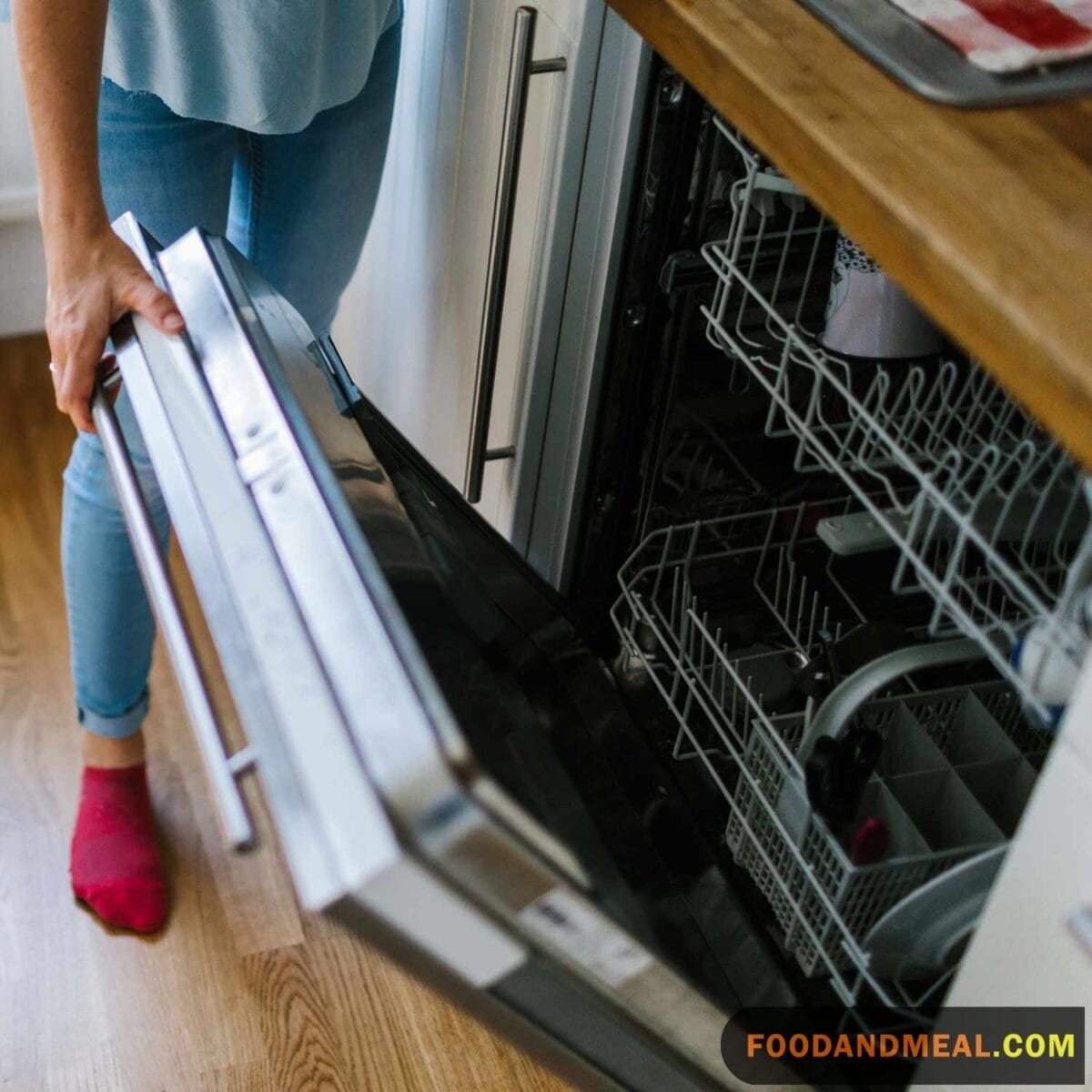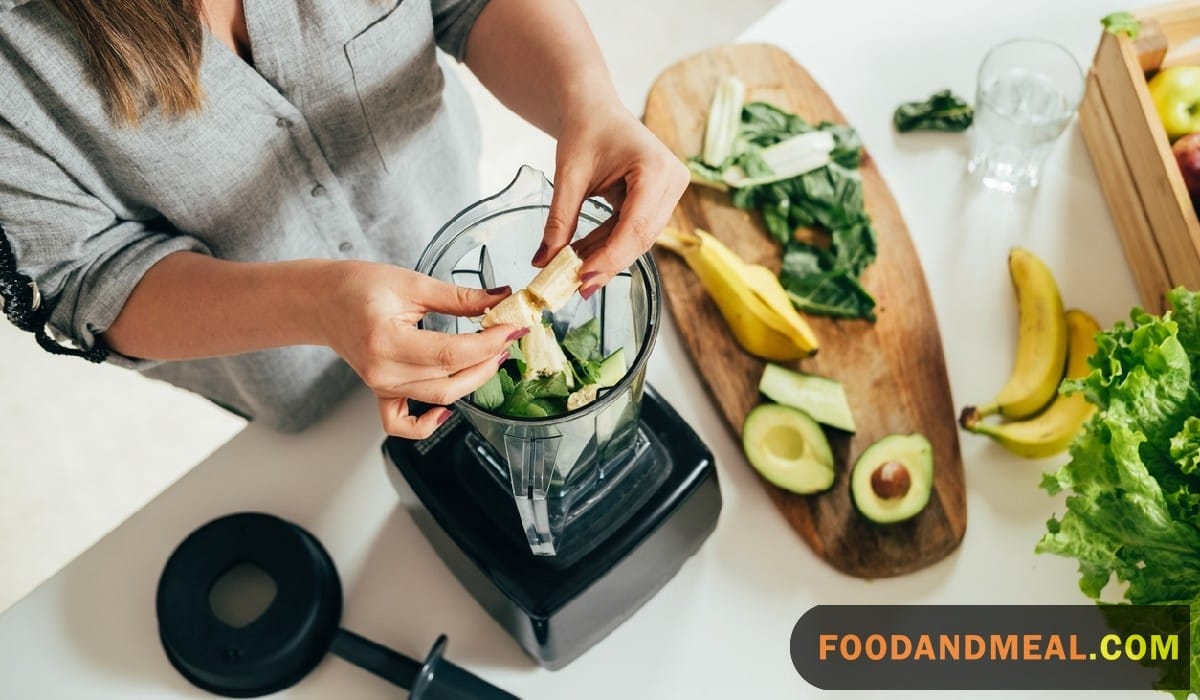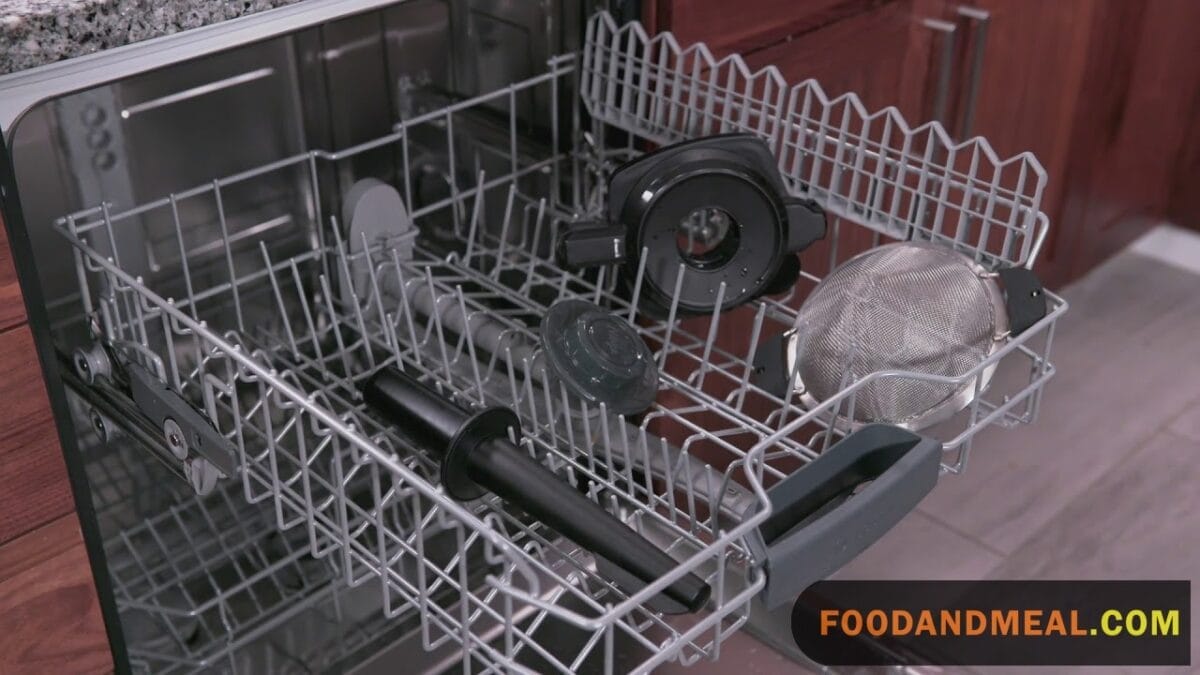A dishwasher is a handy appliance for swiftly cleaning dirty dishes. Many users wonder if it’s suitable for cleaning blenders. The dishwasher is generally safe for cleaning a blender’s jar, lid, blade, and gaskets. However, caution is needed with electrical components or parts with special coatings, as these may not be dishwasher-safe. To ensure proper cleaning, it’s advisable to refer to the manufacturer’s guidelines.
Can You Put A Blender In The Dishwasher ? This article delves into the safety of using dishwashers for cleaning blenders and outlines precautions to take during the cleaning process.
Determining Which Blender Parts Can Be Dishwasher-Safe
Preserving the longevity and performance of your blender involves not only proper usage but also knowing which components can safely undergo dishwasher cleaning. This discussion aims to delineate the blender parts that are suitable and those that are not for the dishwasher.
- Jar / Pitcher: The blender jar, often crafted from materials such as plastic or glass, is generally designed to withstand the dishwasher’s cleaning cycle. These materials are dishwasher-safe, ensuring a convenient cleaning process. However, a word of caution is in order when it comes to using harsh detergents. The presence of special coatings on the jar might be compromised by aggressive cleaning agents. To ensure compatibility, consulting the user manual is a prudent step before placing the jar in the dishwasher.
- Lid: Blender lids, commonly constructed with a combination of rubber and plastic, prove to be resilient during dishwasher cleaning. The materials used in lids are typically dishwasher-safe, making the cleaning process hassle-free. Users can confidently include blender lids in their dishwasher load without concerns about potential damage.
- Blades: The dishwasher safety of blender blades is contingent on their material composition and design intricacies. While dishwasher cleaning may compromise blade sharpness or affect any special coatings, many manufacturers provide assurances of dishwasher compatibility. If the manufacturer explicitly states that the blades are safe for dishwasher use, users can include them in the dishwasher load. Caution should be exercised, however, to avoid harsh detergents during the cleaning process, which might otherwise impact the blades’ integrity.
- Gaskets: Gaskets, often made from food-safe materials like silicone or rubber, can generally withstand the pressure and heat of dishwasher cleaning. These materials are known for their durability and dishwasher compatibility. However, it’s essential to evaluate the quality of the gaskets. If gaskets are deemed fragile or of low quality, it is advisable to refrain from using the dishwasher. Instead, a more gentle cleaning approach, such as wiping them with a damp cloth and mild dish soap, is recommended.
In essence, while many components of blenders are designed to endure the dishwasher, attentiveness to material specifications and manufacturer guidelines is key to maintaining the blender’s optimal performance and longevity. By understanding the dishwasher compatibility of each part, users can confidently incorporate their blender into their cleaning routine, ensuring both convenience and durability.

Blender Parts Unfit for Dishwasher Use
Motor Base and Electrical Components
The motor base and its associated electrical components are categorically unsafe for dishwasher use. The intricate electrical setup within the motor base is highly susceptible to permanent damage from water contact. Introducing these components to water not only compromises their functionality but also escalates the risk of short circuits and potential fire hazards within the base.
Examining Dishwasher Safety for Glass and Plastic Blender Jars:
Blender jars commonly come in two materials: glass and plastic, each with its distinct attributes. Glass jars boast durability and a lower susceptibility to scratches, while plastic jars are cost-effective and exhibit a prolonged lifespan.
Now, the pivotal question arises: Can both glass and plastic blender jars be safely cleaned in the dishwasher? In essence, there is no inherent issue with subjecting them to dishwasher cleaning; however, a few considerations should be taken into account during the process.
Cleaning Glass Jars
When it comes to cleaning glass jars, a strategic approach ensures their longevity and pristine condition. The preferred method involves placing glass jars on the top rack of the dishwasher, a placement that minimizes potential risks during the cleaning cycle. While the dishwasher proves to be a convenient tool, special attention is paramount, especially when it comes to the heat-dry cycle. The intense heat generated during this phase carries the inherent risk of causing cracks in the glass.
Understanding the delicate nature of glass, users are advised to exercise vigilance during the dishwasher’s heat-dry cycle. Taking this precautionary measure helps mitigate the potential vulnerabilities associated with glass exposure to high temperatures, preserving the integrity of the jars and ensuring their continued usability.
Cleaning Plastic Jars
When dealing with plastic jars, a different set of considerations comes into play. Plastic, known for its versatility and cost-effectiveness, can also undergo dishwasher cleaning with a few tailored precautions. Opting for a mild detergent is a key recommendation when dealing with plastic jars. The gentle yet effective cleaning properties of a mild detergent help maintain the structural integrity of the plastic while removing any residues.
Similar to glass jars, caution is advised during the heat-dry phase of the dishwasher cycle. Excessive heat exposure can lead to deformation of the plastic jar. Therefore, users are encouraged to monitor and regulate the heat settings, ensuring that the plastic remains unaffected during the drying process.
General Considerations for Glass and Plastic Materials
Both glass and plastic materials are generally regarded as safe for dishwasher cleaning, provided that users adhere to specific precautions tailored to each material’s characteristics. These considerations are pivotal in mitigating the risk of cracking or deformation during the cleaning process, thereby safeguarding the overall quality and usability of the blender jars.
In essence, while the dishwasher proves to be a valuable ally in maintaining cleanliness, a nuanced understanding of the unique properties of glass and plastic materials empowers users to optimize the cleaning routine. By incorporating these precautions, individuals can confidently preserve the integrity of their blender jars, ensuring a prolonged and effective lifespan for these essential kitchen tools.

Hand Or Dishwasher Cleaning: The Best Blender Cleaning Method
Cleaning a blender can be accomplished either manually or by utilizing a dishwasher, and determining the superior method hinges on individual preferences. Each approach boasts its own set of advantages and drawbacks.
Consider the following chart, which outlines the pros and cons of both manual cleaning and dishwasher cleaning. This comparison aims to assist you in making an informed decision regarding the most suitable cleaning technique based on your personal preferences.
Comparison of Hand Cleaning vs. Dishwasher Cleaning for Blenders:
|
Points |
Hand Cleaning | Dishwasher Cleaning |
|
Cleaning Duration |
Hand cleaning a blender takes a longer time. |
Cleaning a blender in the dishwasher is faster. |
|
Physical Damage |
Hand cleaning causes nearly no damage to the blender. |
If not compatible, the blender has a risk of damage due to the high pressure of the machine. |
|
Difficulty |
Cleaning by hand can be difficult, mainly when the blender is dirty. |
Dishwasher cleaning is so easy, that it requires nothing but pressing a switch. |
|
Comprehensive Cleaning |
You can clean a blender thoroughly with your hand |
Sometimes, the machine can fail to clean the blender thoroughly. |
| Hygiene | Hand cleaning has low hygiene as it is difficult to remove bacteria this way. |
The detergent and heat dry kill bacteria effectively |
This comparative analysis provides insights into the differences between hand cleaning and dishwasher cleaning for blenders, considering factors such as cleaning duration, potential physical damage, difficulty level, the comprehensiveness of cleaning, and hygiene. These considerations can aid in making an informed choice based on individual priorities and preferences.
Precautions Before Putting A Blender In The Dishwasher
Precautions to Safely Clean Your Blender in the Dishwasher:
Read the Cleaning Instructions
Before embarking on the dishwasher cleaning journey, carefully peruse the cleaning instructions outlined in the user manual provided by the blender’s manufacturer. These instructions may contain specific guidelines crucial for maintaining the blender’s integrity during the cleaning process. Adhering to these recommendations is paramount to prevent any inadvertent damage.
Disassemble for Thorough Cleaning
For a meticulous and comprehensive cleaning experience, disassemble all parts of the blender. If feasible, go the extra mile by detaching even the minutest components. This disassembly approach ensures that no food particles remain hidden in hard-to-reach areas, contributing to a more hygienic and effective cleaning outcome.
Top Rack Placement
Exercise caution in the placement of blender components within the dishwasher by consistently positioning them on the top rack. This strategic placement is particularly important due to the potential risks associated with the dishwasher’s heat dry feature, which may lead to melting, deformation, or cracking of the blender parts. Placing them on the top rack mitigates these risks and preserves the integrity of the components.

Select a Gentle Cleaning Cycle
Opt for a dishwasher cycle with a gentle cleaning setting when processing your blender components. Choosing appropriate water pressure levels that align with the blender’s specifications is crucial. Additionally, consult the dishwasher’s specific instructions to identify any recommended settings that can enhance both safety and the overall effectiveness of the cleaning cycle.
Avoid Dishwashing the Motor Base
A critical precautionary measure involves refraining from placing the motor base of the blender in the dishwasher. This sensitive component is best cared for by gently wiping down its surface with a damp cloth immersed in warm water. By avoiding dishwasher exposure, you safeguard the motor base’s structural integrity and functionality.
By meticulously following these precautions, you not only ensure the safety of your blender during dishwasher cleaning but also contribute to its prolonged lifespan and sustained optimal performance. These measures empower you to leverage the convenience of dishwasher cleaning without compromising the integrity of your essential kitchen appliance.
Before initiating the cleaning process for your blender, it’s crucial to ascertain its compatibility with dishwasher usage. Not all blenders are designed to withstand dishwasher cleaning, and attempting to do so without verifying eligibility may result in permanent damage. To confirm whether your blender is suitable for dishwasher cleaning, refer to the manufacturer’s cleaning guidelines provided in the user manual. Adhering to these guidelines ensures that you follow the recommended procedures and precautions for optimal cleaning results. Exercise diligence in checking your blender’s eligibility, and complement this with adherence to cleaning precautions to maintain the appliance’s longevity and functionality.
FAQs about Putting a Blender in the Dishwasher
1. Can I put my blender in the dishwasher? The dishwasher safety of blenders varies by model and brand. Always refer to the manufacturer’s instructions in the user manual to determine if your specific blender is dishwasher safe.
2. Are blender jars dishwasher safe? Blender jars are often made of different materials such as glass or BPA-free plastic. Check the product information to confirm whether the jar is labeled as dishwasher safe. Some blenders only allow specific parts to be dishwasher safe.
3. Can I put the blender blades in the dishwasher? It depends on the blender model. Many blenders have removable blades that are dishwasher safe, but some may require hand washing. Refer to the user manual for guidance on cleaning the blades.
4. What parts of the blender should not be put in the dishwasher? Certain blender components, such as motor bases, electrical components, or parts with sharp blades, should not be submerged in water or placed in the dishwasher. Always check the user manual for specific instructions on what parts are dishwasher safe.
5. Is it safe to put a blender with electronic components in the dishwasher? No, it is not safe to put blenders with electronic components in the dishwasher. The motor base and any electrical components should be kept away from water. Wipe them down with a damp cloth instead.
6. How should I clean a blender that is not dishwasher safe? For blenders that are not dishwasher safe, clean the components by hand using warm, soapy water. Be cautious around sharp blades, and avoid immersing motorized parts in water.
7. Can I put my blender’s rubber gasket in the dishwasher? Many blender gaskets are dishwasher safe, but it’s essential to check the user manual. If the gasket is removable, it’s usually safe to wash on the top rack of the dishwasher.
8. Can I put a high-powered blender in the dishwasher? High-powered blenders, such as those with heavy-duty motors, may have different cleaning requirements. Always refer to the user manual to determine the dishwasher compatibility of your specific high-powered blender.
9. Will using the dishwasher affect the longevity of my blender? Using the dishwasher may affect the longevity of your blender, especially if it’s not designed to be dishwasher safe. Follow the manufacturer’s guidelines to ensure the proper care and maintenance of your blender for optimal performance and durability.
I'm Kelly Atkinson, with a passion for dissecting the world of home goods. My reviews stem from thorough testing and a love for sharing detailed insights. Each piece I write offers a glimpse into my explorative journey, aiming to guide readers to informed choices with authenticity and precision, making every review a blend of exploration and expertise.

